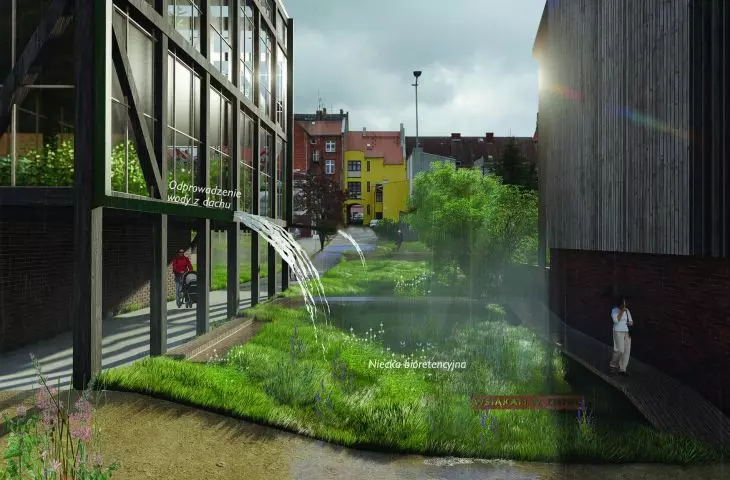Work submitted for the competition
"Best Diploma Architecture"
The project "Between the Old Town and the Warta River" was an urban-architectural task. The starting point was the crisis condition of the downtown area in Międzychód (a town in western Greater Poland). For the design area I chose a quarter located exactly between the market and the riverside areas. It contained a historic frontage on the market side, but required internal reorganization and the addition of a new frontage on the river side. The basic design problems included the city's poor relationship with the Warta River and the internal relations in the local community, all set in the context of natural and climatic conditions.
visualization, frontage
© Arnika Jans
people and space
A significant problem of Międzychód is the outflow of residents and, at the same time, the phenomenon of suburbanization. Even if someone decides to stay in a small town, he or she is looking for a "country house" on the outskirts of the city. The way to meet these expectations is to create a competitive offer in the downtown area.
I decided that the quarter should offer a wide range of housing options. Multifamily townhouses already stood in the existing frontage, so I designed single-family and two-family buildings in the new development strip. The type of home space is also subject to variation.
development
© Arnika Jans
The closing of the quarter itself created an intimate zone for residents inside, but it needed to be organized. It is crystallized by two perpendicularly intersecting axes, on which public and semi-public spaces have been nested.
The north-south axis divides the quarter roughly in half. It is densely built up, surrounded by service functions; it is a formal and communicative link between the most important zones in the city (river - market - lake). Its dominant feature is a greenhouse building with additional rooms for a minidome of culture.
public space
© Arnika Jans
Along the east-west axis, a system of semi-public interiors coupled with many amenities for the community of residents was created. They start on the left from a large open courtyard. Here the zone just outside the buildings is considered semi-private, with no clear vertical fences. On the right side of the establishment, the semi-public space narrows, adjacent to private and semi-private courtyards. These are "softly" fenced off: a natural hedge or a difference in ground level.
visualization, courtyard
© Arnika Jans
The proposed division of space makes it possible to create internal neighborhood communities. Everyone can feel a sense of belonging to a particular part of the quarter.
nature and microclimate
The presence of the river has given rise to considerations about the existence of cities in the context of natural forces. Perhaps the problem of the relationship with the river valley is not only a matter of the lack of recreational infrastructure and insufficient aesthetics of the development, but also a problem of the relationship itself with water, and more broadly with nature. A strategy to rectify this situation is to move toward biocentric design. Therefore, I introduced the following solutions into the design.
diagrams
© Arnika Jans
I planned a sustainable rainwater management system. Bioretention basins and an infiltration ditch that collect water due to the slopes of the land. Rain gardens in pots and "rainwater" tanks that collect rainwater from the roofs of buildings. 45 percent of the site's area is biologically active; part of the paved surface is permeable.
The greenery of the quarter consists of different natural zones: meadows (extensive), wetlands, shrubbery, woodland, vegetable gardens and an orchard. The basis of the introduced vegetation is to be native species. The infrastructure does not impede animal migration.
vegetation
© Arnika Jans
Half of the quarter is threatened by river flooding - "100-year water" - so I used an amphibious architecture solution. The first floors of the buildings are built up, but adapted to periodic flooding and limited to garage and storage functions.
The southern elevation has two layers. An independent structure of verandas with an arcade was "glued" to the actual structure of the exterior wall. A buffer and insulating space was created, which gradually closes or opens, depending on weather conditions. The ceilings of the verandas shade the interior of the apartments in summer, but allow the sun to penetrate in winter.
visualization, courtyard
© Arnika Jans
Some of the buildings inside the quarter have been earmarked for demolition. The demolished building materials are to be used as much as possible on site, including bricks to finish the new buildings, and compacted rubble as walls for raised beds. I have incorporated the remaining foundations and wall fragments into the landscaping.
in the end
Local social renewal and, often overlooked, natural renewal were most important to me in this concept. Finally, I would like to point out that the theoretical project presented is not closed. It only represents an initiating design hypothesis, and its development would be the participation of residents (and other actors) and the process of transforming the site itself.
Arnika JANS
Illustrations: © Author










































